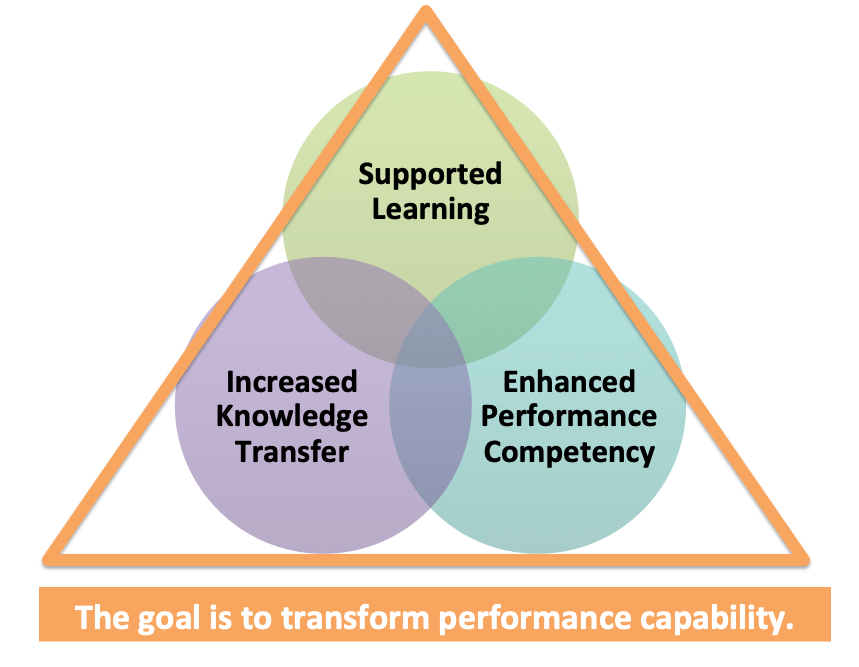
Volunteer Teamwork for Better Results
Looking to improve volunteer teamwork with staff to get things done? There may be something to learn from others who are crossing traditional boundaries in service of better outcomes.
In healthcare, for example, traditional professional boundaries are being challenged. Interdisciplinary teams, made up of professionals from a variety of disciplines, are replacing individual service providers as a strategy to build capacity and improve patient care.
Similarly, volunteer-paid staff collaborations might also be considered “interdisciplinary” in nature, where team members work toward the same goals but from different skill sets, experiences, expectations, and relationships to agency leadership.
Is there something we can learn from healthcare delivery to improve staff-volunteer teams?
A recent study of interdisciplinary healthcare teams in the United Kingdom identified ten characteristics that support success. Below are ten competencies identified by the research, along with my labels. Under each, I suggest a tool or strategy that will support your success.
10 Competencies of an Effective Interdisciplinary Team
- Clear & Supportive Leadership — The team identifies a leader who establishes a clear direction and vision while listening and providing support and supervision.
- Strategy: Participatory Leadership Style
- Guiding Values — The team agrees to a set of values that clearly provide direction for the team that is visible and consistently portrayed.
- Tool: Team Charter
- Collegial Atmosphere — The team demonstrates a culture of trust where contributions are valued and consensus fostered.
- Strategy: Trust-Building Activities
- Standard Ways of Doing — Processes and infrastructures are in place to uphold the team’s vision for service (e.g., communications infrastructure).
- Tool: Team Charter
- Reflective Practice — The team provides quality services with documented outcomes while using feedback to improve.
- Strategy: Team De-Briefs & Knowledge Sharing
- Consensus-based Work — The team promotes intra-team communication, collaborative decision-making and effective team processes.
- Tool: Consensus Decision-making Model
- Team Member Diversity — Team is comprised of an appropriate mix of skills, competencies, and personalities to meet the needs of the project.
- Strategy: Diverse Team Member Personalities
- The Right People — Team members are invited based on existing interdisciplinary competencies, professional knowledge, and experience.
- Tool: Team Position Description with Minimum Qualifications
- Separate Yet Connected — Team acknowledges interdependence while respecting individual roles and autonomy.
- Tools: Team Charter & Project Plan
- Developmental Rewards — The team receives appropriate training, rewards, recognition, and opportunities for personal development.
See: Nancarrow, Susan A, et al., “Ten principles of good interdisciplinary teamwork,” Human Resources for Health, 11:19 (May 2013)
Volunteer Team Building Activities

We rarely think about how we manage. Our management models are as invisible to us as our own breathing. The way we choose to manage is either inadvertent or unconscious — we manage the way we do because that’s how we were taught, it’s reinforced by the organization we work within, it causes the least friction, or it simply matches our personal style best. But, by implementing volunteer team building activities into our leadership model, we may get more out of our teams.
Gary Hamel, professor of strategic and international management at the London Business School encourages those involved in management to consider “management” as a technology that can be strategically designed to work for an organization in the same way a business strategy or service delivery might be developed. In fact, he argues in his webinar Unlocking Opportunity with Business Model Innovation, research shows that innovations in management models, though generally ignored in favor of product or business model innovation, have the highest impact on organizational success. So, if you’re struggling to realize greater program impact, you might want to look first at the way you choose to manage.
Hamel encourages entrenched businesses to imagine themselves as a startup. With a clean sheet of paper, he suggests they begin to imagine a new way of going about the tasks of management. It’s a fascinating exercise, but also extremely difficult. If we’ve never acknowledged the hidden ghost in the machine, the unconscious, knee-jerk processes we employ when we manage, how can we possibly change them for the common good?
Hamel helps us by breaking down the tasks of management into discrete tasks (see my graphic above). He also identifies several key processes where innovation can take place. To generate ideas that might work for nonprofits, I picked five of his tasks and posed two questions for each. These are certainly not the only choices available to you, but they may help you get started thinking about your own management strategy.
Five Team Building Activities You Can Implement
1) Change how priorities get set. Are your team priorities dictated by the requirements of your latest grant, or are they determined by a community needs analysis?
2) Change how performance gets measured. Do you base your performance on how many people are served by your program, or by what happens to them as a result of interacting with you?
3) Change how knowledge gets applied. Does your team decide to try new, but untested approaches because they sound like they might work, or do you have criteria for evaluating potential best practices and a way to catalog them so anyone can use them at any time?
4) Change how resources get allocated. Is the budget process left to the executive level, or are people at all levels for the organization tapped, early in the planning process, for their thoughts on spending priorities and needs?
5) Change how power gets exercised. Are the people who train your team the only ones with the power to decide what information is important enough to share, or can anyone upload and share newsworthy and helpful information in an easy-to-access online open forum.
Hamel also identifies other choices you can make — how opportunities get identified, how strategies get created, how decisions get made, how teams get built, how tasks get assigned, how rewards get shared, and how activities get coordinated.
It can seem overwhelming, but don’t let it be. If you’re serious about changing your management technology, pick one or two areas to innovate. Get started with the decisions you can make at the local level without approval from the higher-ups (which are most of these, thank goodness!). Then, ask your team to help you pose the right questions and make the changes that will benefit everyone.
Utilize Volunteer Mentors to Skyrocket Team Success
Mentoring is a talent management strategy that facilitates learning, knowledge transfer, and enhanced performance competency. The goal is behavior change that leads to acceptable (or better – exceptional) performance levels on the job.
Mentoring replicates the expertise, wisdom, and skills of professionals (in this case, volunteers) in the heads and hands of their co-workers. It uses the right skills at the right time to keep a volunteer workforce prepared, productive, innovative, and competitive.
The Mentoring Trifecta

For mentees, mentoring offers …
- Knowledge sharing that is customized to the individual
- A strong relationship with a resource other than their supervisor
- A way to reinforce knowledge and skills taught in the classroom
- A way to gain confidence in a safe space
- Increased trust in the organization through greater support
For program staff and agencies, mentoring offers …
- A way to quickly and effectively address program needs and learning gaps
- A way to utilize volunteer leaders effectively in a meaningful way
- Higher levels of volunteer proficiency, particularly in direct service environments
- Deeper trust and engagement between new and more seasoned volunteers
What’s more, in the volunteer context, mentoring also adds a social element to learning that resonates well with volunteers who are seeking connection and meaning in their service experiences. And, with higher quality experiences come higher retention rates.
Volunteer Mentoring Models & Types
There are several types of volunteer mentoring models to choose from based on your training and learning needs. With any of the models listed below, conversations can take place in-person, over the phone, or via video chat with little loss of quality.
- Paired (Traditional) Mentoring is focused on providing support in a highly personal, private, or sensitive nature. It is generally issues-based and characterized by high levels of trust and confidentiality. For example, mentors may help a mentee work through a tough interpersonal issue.
- Reverse Mentoring matches those who would more likely be considered mentors, due to their experience or role in the organization, with a less seasoned leader. This is particularly helpful to bring older volunteers up to speed on technology by working with a younger, more adept volunteer. It has also been used by forward-thinking organizational leaders who want a different perspective on how their leadership affects the organization.
- Group Mentoring brings small groups together who are led by a group mentor-facilitator. Groups benefit from hearing challenges and successes and get to learn from diverse peers.
- Situational Mentoring is more about telling than coaching and is focused on providing clutch, just-in-time information so a problem can be overcome quickly. Rather than rely on a small group to offer constant response, some organizations ask mentees to “give back” and act as a mentor once their pressing need has been met.
- Finally, Peer Mentoring involves people at the same hierarchical level in the organization who are matched to offer information, social support, and encouragement. Peers may work in the same or different departments.
Leading your Volunteer Team
In the end, there is no silver bullet, no single way to be a successful leader. Every team and mission will have unique variables that call upon different methodologies and skills. However, there are some essential basics that need to be in place for healthy volunteer team development.
Try on our suggestions for size and watch your team excel.
What would you add to our suggestions for team development or teambuilding activities? Share in the comments!
Leaders like you have exhibited phenomenal spirit and dedication in 2021. And we want to ensure that your voices and experiences are heard.
In this survey we will explore the impacts of COVID on both you and your organization over the past year. We appreciation your participation.
Your answers will be anonymous and the survey takes LESS THAN 5 MINUTES to complete. At the end of the survey, you will be able to register for a free Sneak Peek Webinar where we will share the early results exclusively with participants before the general public.








Leave A Comment